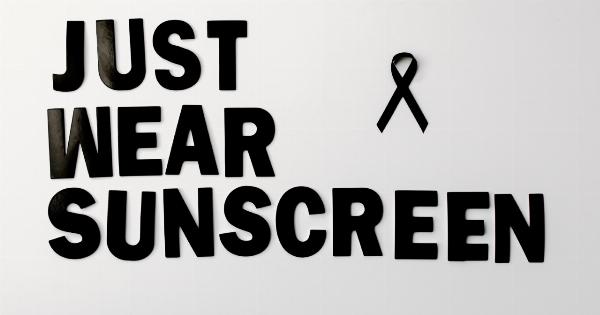For decades, sunscreen has been hailed as a crucial tool in the fight against skin cancer.
With its promise of shielding our skin from harmful ultraviolet (UV) rays, sunscreen has played a significant role in protecting us from sunburns and reducing the risk of developing skin cancer, particularly melanoma. However, the harsh truth is that sunscreen alone may not be as effective as we once believed it to be in preventing melanoma.
The Rise of Melanoma
Melanoma, the most dangerous type of skin cancer, has been on the rise in recent years. Despite extensive public education campaigns about using sunscreen and seeking shade during peak sun hours, melanoma rates continue to increase.
This puzzling trend raises questions about the efficacy of sunscreen and whether it provides adequate protection against this aggressive form of cancer.
Sunscreen’s Limitations
While sunscreen undoubtedly offers some level of protection against UV radiation, its limitations must be acknowledged. The primary factor contributing to its reduced effectiveness is human behavior.
Many people tend to misuse or underuse sunscreen, failing to apply it generously or regularly reapply it as needed. Additionally, individuals often rely solely on sunscreen for protection, neglecting other essential sun safety measures.
The Myth of Sunscreen’s All-Day Protection
One common misconception is that applying sunscreen in the morning provides protection for the entire day. However, most sunscreens have specific instructions for reapplication every two hours, especially after swimming or heavy sweating.
Failing to do so significantly decreases their effectiveness in blocking harmful UV rays. Moreover, exposure to water or excessive sweating can render many sunscreens less effective, as they can easily be rubbed or washed off the skin.
The SPF Fallacy
An often misunderstood aspect of sunscreen is the significance of the Sun Protection Factor (SPF) rating. SPF measures the level of protection against UVB rays but does not account for UVA rays, which also contribute to skin damage and melanoma risk.
Sunscreens with high SPF ratings may create a false sense of security, leading people to spend more time in the sun without additional protective measures.
The Incomplete UV Protection
Sunscreen predominantly shields the skin from UVB rays, which are the primary cause of sunburns. However, UVA rays, which penetrate deeper into the skin, are equally responsible for skin damage, premature aging, and the development of melanoma.
Many sunscreens do not provide sufficient UVA protection, leaving individuals vulnerable to the harmful effects of these rays.
Appropriate Sunscreen Usage
While acknowledging the limitations of sunscreen, it is important to note that it can still play a valuable role in sun protection when used correctly. To maximize its effectiveness:.
1. Choose Broad-Spectrum Sunscreens
Opt for sunscreen products labeled as “broad-spectrum,” as they offer protection against both UVA and UVB rays. Look for UVA-blocking ingredients such as avobenzone, titanium dioxide, or zinc oxide.
2. Use Sunscreens with Higher SPF
While SPF is not an exclusive measure of a sunscreen’s effectiveness against melanoma, using products with higher SPF ratings can provide better UVB protection.
However, remember that SPF should not be the sole factor in your sun protection strategy.
3. Apply Sunscreen Generously
Most people apply sunscreen insufficiently, leading to reduced protection. To ensure proper coverage and effectiveness, use about two tablespoons of sunscreen to cover your entire body and apply it 30 minutes before sun exposure.
4. Reapply Regularly
Remember to reapply sunscreen every two hours or immediately after swimming or sweating excessively. Even water-resistant or sweat-resistant sunscreens lose their effectiveness over time, so diligent reapplication is critical.
5. Seek Shade and Use Protective Clothing
While sunscreen can provide some defense, it should not be your sole line of defense against the sun’s harmful rays.
Seek shade during peak hours when the sun is strongest, and wear protective clothing such as wide-brimmed hats, long sleeves, and sunglasses to further shield your skin.
The Role of Sunscreen in a Comprehensive Sun Protection Strategy
It is crucial to recognize that sunscreen should be just one part of a comprehensive sun protection plan. Relying solely on sunscreen to prevent melanoma is not enough.
Incorporating other protective measures, such as seeking shade, using protective clothing, and avoiding direct sunlight during peak hours, is essential in reducing the risk of skin cancer.
Regular Skin Examinations
Even with diligent sun protection, it is vital to monitor your skin for any signs of melanoma or other skin abnormalities.
Perform regular self-examinations and consult a dermatologist for professional skin screenings, particularly if you have a personal or family history of skin cancer.
Conclusion
Sunscreen undoubtedly plays a role in protecting our skin from UV radiation and reducing the risk of sunburns. However, the harsh truth is that sunscreen alone cannot fully prevent melanoma.
Its limitations, including misuse, incomplete UV protection, and dependence solely on SPF ratings, can compromise its effectiveness. To truly safeguard against melanoma and other skin cancers, a comprehensive approach that combines sunscreen with other protective measures is crucial.
By understanding these limitations and incorporating multiple strategies, we can take significant steps toward reducing the incidence of melanoma and ensuring skin health for years to come.
























